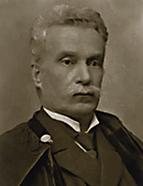

His reflections are rooted in a shared focus on studying Portugal's international relations in the 15th and 16th centuries, artistic migrations, and examining the "most unsuspected testimonies" (Da Arquitetura Manuelina [On Manueline Architecture], 1885, p. 13), the monuments themselves. The description of manueline architecture as non-original (lacking a rigorous layout, clear determination of functions, and a cohesive system of ornamentation) is not simply about noting an eclecticism that is able to accept the old and the new: in the "indiscipline" of the arts, he sees a reflection of the indiscipline of customs, a successive disorganisation and a lack of proper schooling, teaching, and study; the evidence of the "dissolving seeds" of an era, which finds parallel in his 19th century. Historical analysis, therefore, necessarily involves a moral examination.
His time-consuming, distinguished, and painstaking work was recognised throughout his life by various institutions: he became associated with Gesellschaft für Musikforschung in Berlin (1874) for his musicological expertise; with the Sociedade de Geografia de Lisboa [Lisbon Geographical Society] (1876); with the Imperial Germanic Institute of Archaeology (1878); with the Royal Academy of Fine Arts of San Fernando, in Spain (1878). He was a corresponding member of the Comissão dos Monumentos Nacionais [National Monuments Commission] (1896-1898), collaborated with the Conselho dos Monumentos Nacionais [National Monuments Council] (starting in 1902), and served as a full member of the Arte e Arqueologia da Circunscrição do Norte [Art and Archaeology Commission of the Northern District] (1910-1932). He was a scholar of merit at the Academia Nacional de Belas-Artes [National Academy of Fine Arts] and a scholar of literary merit at the Escola de Belas-Artes do Porto [Porto School of Fine Arts] (Joaquim de Vasconcelos: historiador, crítico de arte..., p. 40).
Many other organisations also honoured him: the Real Associação dos Arquitetos e Arqueólogos [Royal Association of Architects and Archaeologists], of which he was a full member, awarded him the institution's silver medal (1879); the Royal Academy of Music in Florence (1881); the Sociedade Martins Sarmento [Martins Sarmento Society] (1882), the Escola Livre das Artes do Desenho de Coimbra [Coimbra Free School of Drawing Arts] and the Ateneu Comercial do Porto [Porto Commercial Athenaeum] elect him honorary member (Idem, p. 146); the Escola de Belas-Artes do Porto [Porto School of Fine Arts] granted him the title of scholar of literary merit (1908). He was also a patron member of the Associação Industrial Portuguesa [Portuguese Industrial Association] (1890). At the age of 80, the Portuguese government awarded him the Grand Officer of the Order of St James (1929) (Idem, p. 255).
This work is financed by national funds through FCT - Foundation for Science and Technology, I.P, in the scope of the projects UIDB/04311/2020 and UIDP/04311/2020.
